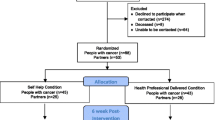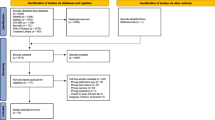Abstract
Purpose
The purpose of this study was to conduct a preliminary validation of the psychometric performance of the newly developed Self-Efficacy to Communicate about Sex and Intimacy (SECSI) scale in a sample of women treated for cancer.
Methods
Partnered women (n = 250) who had received treatment for cancer completed an online survey that included the SECSI scale and measures of health-related quality of life, depression, anxiety, sexual function, sexual distress, self-efficacy for sexual functioning, sexual behaviors, relationship satisfaction, and satisfaction with sexual communication. Sociodemographic and clinical cancer characteristics data were collected.
Results
High internal consistency and strong test–retest reliability of the SECSI scale were shown with a Cronbach’s alpha coefficient of 0.94 and test–retest reliability of r = 0.82, respectively. Construct validity of the SECSI scale, including discriminant, convergent, and divergent validity, was supported except regarding hypothesized relationships between SECSI scores and participant age and time since treatment.
Conclusions
The SECSI scale is a valid, reliable measure for use with partnered women treated for cancer. Clinicians working with cancer survivors who may be at risk for difficulties communicating about sex and intimacy needs after cancer treatment may use this scale to identify women who would benefit from interventions to increase their confidence to communicate with their partner. The SECSI scale fills an important gap in ability to assess self-efficacy to communicate about sex and intimacy.
Similar content being viewed by others
References
National Cancer Institute (2017) Surveillance, Epidemiology, and End Results (SEER) program [internet]. Bethesda, MD. Available from: www.seer.cancer.gov. Accessed 10 Dec 2017
Juraskova I, Butow P, Bonner C, Robertson R, Sharpe L (2013) Sexual adjustment following early stage cervical and endometrial cancer: prospective controlled multi-centre study. Psychooncology 22:153–159
Sadovsky R, Basson R, Krychman M, Morales AM, Schover L, Wang R et al (2010) Cancer and sexual problems. J Sex Med 7:349–373
Tierney K (2008) Sexuality: a quality of life issue for cancer survivors. Semin Oncol Nurs 24:71–79
Stark TC, Visovsky C, McMillan SC (2012) The symptom experience of patients with cancer. J Hosp Palliat Nurs 14:61–70
Breukink SO, Donovan KA (2013) Physical and psychological effects of treatment on sexual functioning in colorectal cancer survivors. J Sex Med 10(Suppl 1):74–83
Carter J, Stabile C, Gunn A, Sonoda Y (2013) The physical consequences of gynecologic cancer surgery and their impact on sexual, emotional, and quality of life issues. J Sex Med 10(Suppl 1):21–34
Den Oudsten BL, Traa MJ, Thong MSY, Martijn H, De Hingh IHJT, Bosscha K et al (2012) Higher prevalence of sexual dysfunction in colon and rectal cancer survivors compared with the normative population: a population-based study. Eur J Cancer Oxf Engl 1990 48:3161–3170
Perz J, Ussher JM, Gilbert E, Australian Cancer and Sexuality Study Team (2014) Feeling well and talking about sex: psycho-social predictors of sexual functioning after cancer. BMC Cancer 14:228
Raggio GA, Butryn ML, Arigo D, Mikorski R, Palmer SC (2014) Prevalence and correlates of sexual morbidity in long-term breast cancer survivors. Psychol Health 29:632–650
Manne OJS, Norton TR, Fox K, Goldstein L, Grana G (2006) Cancer-related relationship communication in couples coping with early stage breast cancer. Psychooncology 15:234–247
Kayser K, Acquati C, Reese JB, Mark K, Wittmann D, Karam E (2018) A systematic review of dyadic studies examining relationship quality in couples facing colorectal cancer together. Psychooncology 27:13–21
Lindau ST, Anderson D, Gavrilova N (2007) Sexual morbidity in very long-term survivors of vaginal and cervical cancer: a comparison to national norms. Gynecol Oncol 106:413–418
Manne SM, Ross S, Ostroff J, Heyman RE, Fox K (2004) Couples’ support-related communication, psychological distress, and relationship satisfaction among women with early stage breast cancer. J Consult Clin Psychol 72:660–670
Shin DW, Shin J, Kim SY, Yang H-K, Cho J, Youm JH et al (2015) Family avoidance of communication about cancer: a dyadic examination. Cancer Res Treat 48:384–392
Yu Y, Sherman KA (2015) Communication avoidance, coping and psychological distress of women with breast cancer. J Behav Med 38:565–577
Brotto LA, Yule M, Breckon E (2010) Psychological interventions for the sexual sequelae of cancer: a review of the literature. J Cancer Surviv Res Pract 4:346–360
Scott JL, Kayser K (2009) A review of couple-based interventions for enhancing women’s sexual adjustment and body image after cancer. Cancer J Sudbury Mass 15:48–56
Manne S, Badr H (2008) Intimacy and relationship processes in couples’ psychosocial adaptation to cancer. Cancer 112:2541–2555
Perz J, Ussher JM, Gilbert E (2013) Constructions of sex and intimacy after cancer: Q methodology study of people with cancer, their partners, and health professionals. BMC Cancer 13:270
Bandura A (2006) Guide for constructing self-efficacy scales. In F. Pajares and T. Urdan (Eds.). Self-efficacy beliefs of adolescents, (Vol. 5., pp. 307-337). Greenwich, CT: Information Age Publishing
Bandura A (1998) Health promotion from the perspective of social cognitive theory. Psychol Health 13:623–649
Catania JA (1998) Dyadic sexual communication. In: Davis CM, Yarber WL, Bauserman R, Schreer G, Davis LD, eds. Handbook of sexuality‐related measures. Thousand Oaks: SAGE Publications, Inc.; :129–131
Bailes S, Creti L, Fichten CS, Libman E, Brender W, and Amsel R (2010). Sexual Self-Efficacy Scale for Female Functioning. In T. D. Fisher, C. M., Davis, W. L. Yarber, S. L., Davis (Eds.). Handbook of sexuality-related measures. New York: Routledge
Traa DVJ, Roukema JA, Den Oudsten BL (2012) Sexual (dys)function and the quality of sexual life in patients with colorectal cancer: a systematic review. Ann Oncol 23:19–27
Webster K, Cella D, Yost K (2003) The functional assessment of chronic illness therapy (FACIT) measurement system: properties, applications, and interpretation. Health Qual Life Outcomes 1:79
Levin AO, Carpenter KM, Fowler JM, Brothers BM, Andersen BL, Maxwell GL (2010) Sexual morbidity associated with poorer psychological adjustment among gynecological cancer survivors. Int J Gynecol Cancer 20:461–470
Spitzer RL, Kroenke K, Williams JBW, Löwe B (2006) A brief measure for assessing generalized anxiety disorder: the GAD-7. Arch Intern Med 166:1092–1097
Kroenke K, Spitzer RL, Williams JB (2001) The PHQ-9: validity of a brief depression severity measure. J Gen Intern Med 16:606–613
Rosen R, Brown C, Heiman J, Leiblum S, Meston C, Shabsigh R et al (2000) The female sexual function index (FSFI): a multidimensional self-report instrument for the assessment of female sexual function. J Sex Marital Ther 26:191–208
Baser RE, Li Y, Carter J (2012) Psychometric validation of the female sexual function index (FSFI) in cancer survivors. Cancer 118:4606–4618
Derogatis CA, Lewis-D’Agostino D, Wunderlich G, Fu Y (2008) Validation of the female sexual distress scale—revised for assessing distress in women with hypoactive sexual desire disorder. J Sex Med 5:357–364
Hunsley J, Best M, Lefebvre M, Vito D (2001) The seven-item short form of the dyadic adjustment scale: further evidence for construct validity. Am J Fam Ther 29:325–335
Arthur EA, Menon U (2016) Measure development and face validity of a self-efficacy for communicating about sex scale. [Poster] 2016 oncology nursing dociety annual congress. San Antonio, TX. https://onf.ons.org/onf.ons.org/onf/43/2/podium-poster-and-research-abstracts
Arthur E, Menon U, and Wills C (2018) Cognitive interviews with women cancer survivors to assess content validity of the self-efficacy to communicate about sex and intimacy (SECSI) scale. [Oral Presentation; Distinguished Abstract] Midwest Nursing Research Society Annual Conference, Cleveland, Ohio.
IBM Corp. Released 2016. IBM SPSS Statistics for Windows, Version 24.0. Armonk, NY: IBM Corp
Nunnally J, Bernstein I (1994) Psychometric theory, 3rd edn. McGraw-Hill, United States of America
Pazmany BS, Verhaeghe J, Van Oudenhove L, Enzlin P (2015) Dyadic sexual communication in pre-menopausal women with self-reported dyspareunia and their partners: associations with sexual function, sexual distress and dyadic adjustment. J Sex Med 12:516–528
Rancourt KM, Rosen NO, Bergeron S, Nealis LJ (2016) Talking about sex when sex is painful: dyadic sexual communication is associated with women’s pain, and couples’ sexual and psychological outcomes in provoked vestibulodynia. Arch Sex Behav 45:1933–1944
Arthur E, Wills C, Menon U (2018) A systematic review of interventions for sexual well-being in women with gynecologic, anal, or rectal cancer. Oncol Nurs Forum 45:469–482
Brucker PS, Yost K, Cashy J, Webster K, Cella D (2005) General population and cancer patient norms for the functional assessment of cancer therapy—general (FACT-G). Eval Health Prof 28:192–211
Sarkar S, Sautier L, Schilling G, Bokemeyer C, Koch U, Mehnert A (2015) Anxiety and fear of cancer recurrence and its association with supportive care needs and health-care service utilization in cancer patients. J Cancer Surviv 9:567–575
Hartung TJ, Brähler E, Faller H, Härter M, Hinz A, Johansen C et al (2017) The risk of being depressed is significantly higher in cancer patients than in the general population: prevalence and severity of depressive symptoms across major cancer types. Eur J Cancer 72:46–53
Schover LR, Baum GP, Fuson LA, Brewster A, Melhem-Bertrandt A (2014) Sexual problems during the first 2 years of adjuvant treatment with aromatase inhibitors. J Sex Med 11:3102–3111
Milbury K, Cohen L, Jenkins R, Skibber JM, Schover LR (2013) The association between psychosocial and medical factors with long-term sexual dysfunction after treatment for colorectal cancer. Support Care Cancer 21:793–802
Acknowledgments
We would like to express our sincere gratitude to the women cancer survivors who participated in this research.
Funding
Funding for this research was provided in part by the Oncology Nursing Society Foundation Endowment 2017 ONS Foundation Dissertation Research Grant and by a Sigma Theta Tau International Epsilon Chapter Dissertation Grant.
Author information
Authors and Affiliations
Corresponding author
Ethics declarations
Ethical approval
All procedures performed in this study involving human participants were in accordance with the ethical standards of the institutional and/or national research committee and with the 1964 Helsinki declaration and its later amendments or comparable ethical standards. Informed consent was obtained from all individual participants included in the study.
Conflict of interest
None of the authors has a financial relationship with the foundations that sponsored this research. We have control of all primary data and agree to allow the journal to review the data if requested.
Additional information
Publisher’s note
Springer Nature remains neutral with regard to jurisdictional claims in published maps and institutional affiliations.
Rights and permissions
About this article
Cite this article
Arthur, E.K., Wills, C.E., Browning, K. et al. The Self-Efficacy to Communicate about Sex and Intimacy (SECSI) scale: psychometric assessment in women treated for cancer. Support Care Cancer 28, 1449–1457 (2020). https://doi.org/10.1007/s00520-019-04963-2
Received:
Accepted:
Published:
Issue Date:
DOI: https://doi.org/10.1007/s00520-019-04963-2




